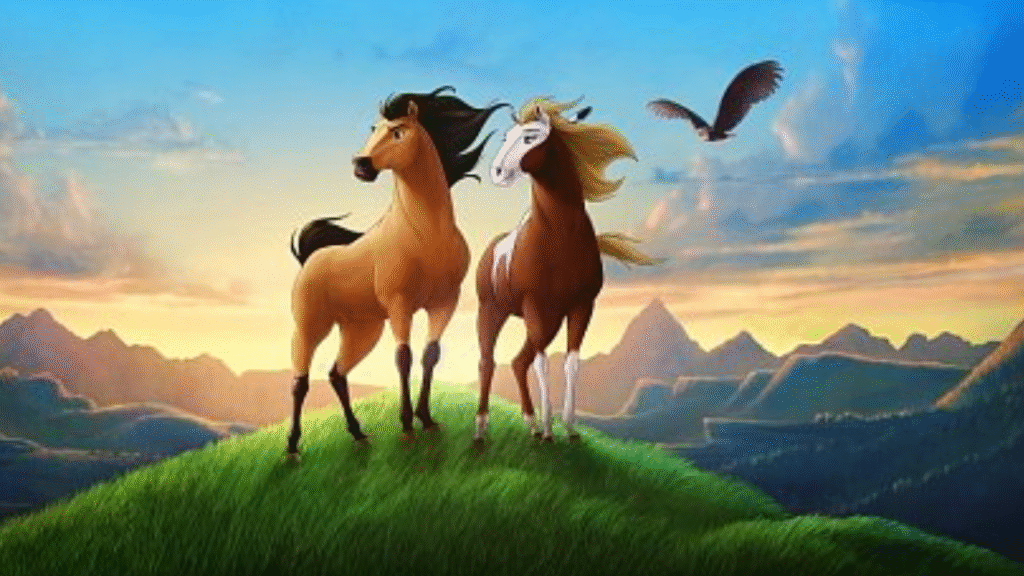The enduring image of the wild Kiger mustang, Spirit, thundering across the American West, nostrils flaring against a painted sunset, is etched into the minds of a generation. DreamWorks Animation’s 2002 masterpiece, “Spirit: Stallion of the Cimarron,” captured hearts with its breathtaking animation, powerful score, and a unique narrative told almost entirely from the horse’s perspective, devoid of anthropomorphic dialogue. It wasn’t just a children’s film; it was a resonant tale of freedom, resilience, and the unbreakable bond between horse and human. Over a decade later, a new chapter emerged, stepping away from the lush animation into the gritty reality of live-action: “Spirit of the Stallion” (2017). This film promised a continuation, a deeper exploration of the legend. But does it capture the magic of its predecessor, or does it trot down a different, less compelling trail? This comprehensive review examines the legacy, execution, and heart of Spirit of the Stallion.
Bridling Expectations: Understanding the Context of the Sequel
Before dissecting the Spirit of the Stallion, it’s crucial to set the stage. Unlike a direct sequel produced by DreamWorks Animation, this film is a live-action independent production directed by Sean McNamara. It positions itself not as a replacement for the animated classic, but as a companion piece exploring the mythology surrounding the legendary horse, Spirit. The film begins by acknowledging the animated origin, cleverly using stylized cave paintings to recount Spirit’s initial capture, escape, and bond with Little Creek. This grounding immediately signals an attempt to honor the original while forging its own path. The core premise shifts: instead of Spirit himself as the protagonist, the story centers on a young Native American boy, Little Creek (now portrayed as a respected elder, played by C. Thomas Howell), recounting the legend of Spirit to his grandson, Koda (Lukas Engel). Koda, struggling with the loss of his own horse, finds inspiration and courage in his grandfather’s tales, particularly the saga of Spirit of the Stallion. This framing device establishes the film’s central theme: the enduring power of stories and legends to heal, guide, and inspire courage across generations.
Production, Story and Characters in Spirit of the Stallion
- The Live-Action Transition: Pros and Cons: The most striking departure from the original is the shift to live-action. Spirit of the Stallion showcases real horses and authentic Southwestern landscapes (filmed in Utah). This brings a tangible realism and weight to the equine characters. Seeing the power and grace of the horses, particularly the magnificent stallion portraying Spirit, is undeniably compelling. Cinematography captures sweeping vistas, emphasizing the vastness and beauty of the West. However, this realism also creates limitations. The nuanced expressiveness achieved through animation in the original – Spirit’s defiant glare, his subtle communication with Rain – is harder to replicate with real animals. While the horse acting is often impressive, the emotional depth conveyed solely through equine body language and human interpretation sometimes falls short of the animated predecessor’s eloquence. The visual effects used for some action sequences and dreamlike visions also feel noticeably lower-budget compared to modern blockbusters.
- Narrative Structure: Legend Within a Story: The film operates on two intertwined levels: the present-day story of Koda grappling with grief and responsibility, and the historical legend of Spirit as recounted by Little Creek. This structure allows Spirit of the Stallion to explore themes of legacy, mentorship, and overcoming fear through Koda’s journey, while simultaneously delivering the expected horse-centric adventure through the flashback sequences. The legend portion follows familiar beats: Spirit’s capture by ruthless horse traders, his indomitable will refusing submission, his encounters with adversity, and his eventual path back towards freedom and his herd, encountering allies along the way. The inclusion of characters like a sympathetic cavalry officer adds a new dimension to the conflict.
- Characterization: Humans and Horses: Lukas Engel delivers a sincere performance as Koda, effectively portraying a young boy burdened by loss and self-doubt, gradually finding his inner strength. C. Thomas Howell brings gravitas and warmth to Elder Little Creek, embodying the wisdom-keeper role. The human antagonists (the horse traders) are suitably menacing, though somewhat archetypal. The true stars, however, are the horses. The stallion playing Spirit possesses a commanding presence. His defiance, intelligence, and sheer physicality are central to the film’s most engaging moments. The bond between Spirit and the key human character within the legend (a young woman who aids him) is developed with sensitivity, echoing the connection seen with Little Creek in the original.
Where Spirit of the Stallion Finds its Herd
Understanding the target audience and context is key to appreciating Spirit of the Stallion:
- Families Seeking Live-Action Animal Adventures: For families who enjoy live-action horse films like Black Beauty or Flicka, Spirit of the Stallion offers a wholesome, adventure-driven story with positive messages about courage, perseverance, and respect for animals. The lower intensity of conflict (compared to gritty Westerns) makes it suitable for younger viewers who love horses.
- Fans of the Original Seeking Expanded Lore: While not a direct continuation, the film explicitly acknowledges and builds upon the Spirit mythology established in the animated film. For fans curious about how the legend of Spirit might be passed down or depicted in a different medium, Spirit of the Stallion provides an interesting, albeit different, perspective. It offers a “what if” glimpse into how the tale might be told around a campfire generations later.
- Educational Value – History and Culture: The film lightly touches upon themes relevant to the late 19th-century American West – the changing frontier, conflicts over land and resources, the relationship between Native American tribes and encroaching settlers/cavalry. While not a deep historical drama, it provides a springboard for discussions about this era and the cultural significance of horses. The emphasis on storytelling within Native American tradition is also a valuable element.
- Appreciation of Equine Beauty: Cinematically, the film serves as a showcase for magnificent horses and stunning landscapes. Viewers who simply enjoy watching well-filmed equine action and the beauty of the natural world will find visual satisfaction.
Frequently Asked Questions (FAQs)
- Is “Spirit of the Stallion” a direct sequel to the DreamWorks animated “Spirit: Stallion of the Cimarron”?
No. It is an independent, live-action film that positions itself as exploring the legend of the horse Spirit, inspired by and acknowledging the animated film. It features a framing story set later, with an elder recounting Spirit’s tale to his grandson. Think of it as a companion piece or a different interpretation of the mythos.
- Do I need to see the original animated movie first?
While not strictly necessary, it’s highly recommended. Spirit of the Stallion opens by summarizing the key events of the original animated film (Spirit’s capture, escape, bond with Little Creek) through stylized cave paintings. Understanding the source material enriches the context of the legend being told within this new film and highlights the connections and differences.
- Is this movie suitable for young children?
Generally, yes. Spirit of the Stallion is rated PG. It contains scenes of horse wrangling, capture, and mild peril (e.g., horses running through fire, confrontations with antagonists), but the violence is not graphic. The themes of loss (Koda’s horse) and overcoming fear are handled sensitively. It’s less intense than many live-action adventure films but more grounded than the animated original. Parental discretion for very sensitive children is always wise.
- How does the live-action portrayal compare to the animation?
It’s fundamentally different. The animation allowed for exaggerated expressions, dynamic impossible camera angles, and a deeply internal perspective from Spirit. The live-action Spirit of the Stallion offers realism, tangible horse presence, and beautiful scenery. The emotional connection relies more on the human characters reacting to the horse and the horse’s physical acting, which, while impressive, lacks the nuanced internal monologue achieved through animation. The visual effects are also less sophisticated.
Conclusion: The Enduring Echo of Hoofbeats
Spirit of the Stallion is a film that walks a deliberate, if sometimes uneven, path. It doesn’t attempt to replicate the groundbreaking animation or the purely equine perspective of its illustrious predecessor. Instead, it carves out its own niche as a live-action family adventure steeped in the legend of that iconic horse. Its strengths lie in the genuine beauty of its equine stars, the breathtaking Southwestern landscapes, sincere performances from its young lead and seasoned elder, and its heartfelt exploration of intergenerational storytelling, courage, and healing from loss.
However, to dismiss Spirit of the Stallion based solely on comparisons would be to overlook its genuine merits. It serves a distinct audience: families seeking wholesome live-action animal adventures, fans of the original curious about an expanded (if different) lore, and viewers who simply appreciate well-photographed horses and scenery. It delivers positive messages about resilience, respecting nature, and the importance of heritage and stories. The spirit of freedom that defined the animated Spirit still gallops through this film, albeit viewed through a different lens – the lens of legend passed down through time.



